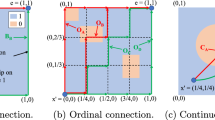Abstract
Counterfactual explanations describe how an outcome can be changed to a more desirable one. In XAI, counterfactuals are “actionable” explanations that help users to understand how model decisions can be changed by adapting features of an input. A case-based approach to counterfactual discovery harnesses Nearest-unlike Neighbours as the basis to identify the minimal adaptations needed for outcome change. This paper presents the DisCERN algorithm which uses the query, its NUN and substitution-based adaptation operations to create a counterfactual explanation case. DisCERN uses Integrated Gradients (IntG) feature attribution as adaptation knowledge to order substitution operations and to bring about the desired outcome with as few changes as possible. We present our novel approach with IntG where the NUN is used as the baseline against which the feature attributions are calculated. DisCERN also uses feature attributions to identify a NUN closer to the query, and thereby minimise the total change needed, but results suggest that the number of feature changes can increase. Overall, DisCERN outperforms other counterfactual algorithms such as DiCE and NICE in generating valid counterfactuals with fewer adaptations.
This research is funded by the iSee project (https://isee4xai.com) which received funding from EPSRC under the grant number EP/V061755/1.
Access this chapter
Tax calculation will be finalised at checkout
Purchases are for personal use only
Similar content being viewed by others
References
Li, O., Liu, H., Chen, C., Rudin, C.: Deep learning for case-based reasoning through prototypes: a neural network that explains its predictions. In: 32nd AAAI Conference on Artificial Intelligence, pp. 3530–3537 (2018)
Arrieta, A.B., et al.: Explainable artificial intelligence (XAI): concepts, taxonomies, opportunities and challenges toward responsible AI. Inf. Fusion 58, 82–115 (2020)
Kenny, E.M., Keane, M.T.: Twin-systems to explain artificial neural networks using case-based reasoning: comparative tests of feature-weighting methods in ANN-CBR twins for XAI. In: IJCAI-19, pp. 2708–2715, IJCAI (2019)
Wettschereck, D., Aha, D.W., Mohri, T.: A review and empirical evaluation of feature weighting methods for a class of lazy learning algorithms. Artif. Intell. Rev. 11(1), 273–314 (1997)
Craw, S., Massie, S., Wiratunga, N.: Informed case base maintenance: a complexity profiling approach. In: AAAI, pp. 1618–1621 (2007)
Byrne, R.M.: Counterfactuals in explainable artificial intelligence (XAI): evidence from human reasoning. In: IJCAI, pp. 6276–6282 (2019)
Keane, M.T., Smyth, B.: Good counterfactuals and where to find them: a case-based technique for generating counterfactuals for explainable AI (XAI). In: Watson, I., Weber, R. (eds.) ICCBR 2020. LNCS (LNAI), vol. 12311, pp. 163–178. Springer, Cham (2020). https://doi.org/10.1007/978-3-030-58342-2_11
Brughmans, D., Martens, D.: Nice: an algorithm for nearest instance counterfactual explanations. arXiv preprint arXiv:2104.07411 (2021)
Wiratunga, N., Wijekoon, A., Nkisi-Orji, I., Martin, K., Palihawadana, C., Corsar, D.: Discern: discovering counterfactual explanations using relevance features from neighbourhoods. In: 33rd ICTAI, pp. 1466–1473. IEEE (2021)
Craw, S., Wiratunga, N., Rowe, R.C.: Learning adaptation knowledge to improve CBR. Artif. Intell. 170(16–17), 1175–1192 (2006)
Sundararajan, M., Taly, A., Yan, Q.: Axiomatic attribution for deep networks. In: International Conference on Machine Learning, pp. 3319–3328. PMLR (2017)
Mothilal, R.K., Sharma, A., Tan, C.: Explaining machine learning classifiers through diverse counterfactual explanations. In: Proceedings of the 2020 Conference on Fairness, Accountability, and Transparency, pp. 607–617 (2020)
Karimi, A.-H., Barthe, G., Balle, B., Valera, I.: Model-agnostic counterfactual explanations for consequential decisions. In: International Conference on Artificial Intelligence and Statistics, pp. 895–905. PMLR (2020)
Ribeiro, M.T., Singh, S., Guestrin, C.: Why should i trust you? explaining the predictions of any classifier. In: 22nd ACM SIGKDD, pp. 1135–1144 (2016)
Lundberg, S.M., Lee, S.-I.: A unified approach to interpreting model predictions. Adv. Neural. Inf. Process. Syst. 30, 4765–4774 (2017)
Li, J., Zhang, C., Zhou, J.T., Fu, H., Xia, S., Hu, Q.: Deep-lift: deep label-specific feature learning for image annotation. IEEE Trans. Cybern. (2021)
Qi, Z., Khorram, S., Li, F.: Visualizing deep networks by optimizing with integrated gradients. In: CVPR Workshops, vol. 2 (2019)
Author information
Authors and Affiliations
Corresponding author
Editor information
Editors and Affiliations
Rights and permissions
Copyright information
© 2022 The Author(s), under exclusive license to Springer Nature Switzerland AG
About this paper
Cite this paper
Wijekoon, A., Wiratunga, N., Nkisi-Orji, I., Palihawadana, C., Corsar, D., Martin, K. (2022). How Close Is Too Close? The Role of Feature Attributions in Discovering Counterfactual Explanations. In: Keane, M.T., Wiratunga, N. (eds) Case-Based Reasoning Research and Development. ICCBR 2022. Lecture Notes in Computer Science(), vol 13405. Springer, Cham. https://doi.org/10.1007/978-3-031-14923-8_3
Download citation
DOI: https://doi.org/10.1007/978-3-031-14923-8_3
Published:
Publisher Name: Springer, Cham
Print ISBN: 978-3-031-14922-1
Online ISBN: 978-3-031-14923-8
eBook Packages: Computer ScienceComputer Science (R0)




